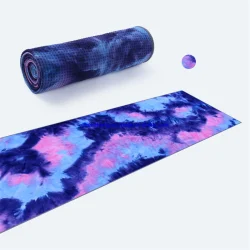Here are some key aspects of yoga blankets
2024-03-05
A yoga blanket is a versatile prop commonly used in yoga practice to provide comfort, support, and warmth during various poses and relaxation exercises. These blankets are typically made from soft, durable, and easy-to-clean materials. Here are some key aspects of yoga blankets:
1. Material:
- Yoga blankets are often made from different materials, including cotton, wool, or a blend of fibers. Cotton blankets are soft and breathable, while wool blankets offer warmth and insulation.
2. Size and Dimensions:
- Yoga blankets come in various sizes, but a standard size is approximately 60 inches by 80 inches. This size allows for a range of uses, from providing cushioning in seated poses to covering the body during relaxation or meditation.
3. Thickness:
- Yoga blankets vary in thickness. Thicker blankets may offer more support and cushioning, making them suitable for sitting or lying poses, while thinner blankets are more lightweight and may be preferred for certain poses or as a cover during relaxation.
4. Texture:
- The texture of yoga blankets can vary. Some blankets have a smooth and even texture, while others may have a more textured or woven surface. The choice of texture can depend on personal preference and the intended use of the blanket.
5. Color Options:
- Yoga blankets come in a variety of colors, allowing practitioners to choose based on personal preferences or to match the overall aesthetic of their yoga practice space.
6. Versatility:
- Yoga blankets have multiple uses in a yoga practice:
- Support: Folded or rolled to provide support in seated poses, under the knees, or during restorative poses.
- Warmth: Used as a cover during relaxation or meditation to keep the body warm.
- Props: Rolled up to create a bolster for additional support in various poses.
- Alignment: Folded to lift and support certain body parts for proper alignment.
- Cushioning: Placed under sensitive areas, such as the head or tailbone, to add comfort during poses.
7. Cleaning and Maintenance:
- Most yoga blankets are machine washable, and they are generally easy to clean. It's important to follow care instructions to maintain the blanket's quality.
8. Eco-Friendly Options:
- Some yoga blankets are made from organic or sustainable materials, catering to those who prioritize environmentally friendly products.
9. Portability:
- Yoga blankets are lightweight and easy to carry, making them a convenient accessory for both studio and home practice.
10. Traditional Use:
- In certain styles of yoga, such as Iyengar, yoga blankets are commonly used as props to provide support, stability, and alignment assistance.
Yoga blankets are versatile props that can enhance your practice by adding comfort and support. Whether you use them for warmth during relaxation or as a prop to modify and deepen poses, having a yoga blanket can contribute to a more enjoyable and fulfilling yoga experience.



